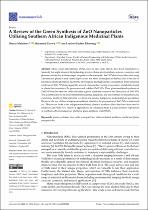| dc.contributor.author | Mutukwa, Dorcas | |
| dc.contributor.author | Taziwa, Raymond | |
| dc.contributor.author | Khotseng, Lindiwe Eudora | |
| dc.date.accessioned | 2022-11-03T08:17:06Z | |
| dc.date.available | 2022-11-03T08:17:06Z | |
| dc.date.issued | 2022 | |
| dc.identifier.citation | Mutukwa, D. et al. (2022). A review of the green synthesis of zno nanoparticles utilising Southern African indigenous medicinal plants. Nanomaterials, 12(19), 3456. https://doi.org/10.3390/nano12193456 | en_US |
| dc.identifier.issn | 2079-4991 | |
| dc.identifier.uri | https://doi.org/10.3390/nano12193456 | |
| dc.identifier.uri | http://hdl.handle.net/10566/8147 | |
| dc.description.abstract | Metal oxide nanoparticles (NPs), such as zinc oxide (ZnO), have been researched extensively
for applications in biotechnology, photovoltaics, photocatalysis, sensors, cosmetics, and
pharmaceuticals due to their unique properties at the nanoscale. ZnO NPs have been fabricated using
conventional physical and chemical processes, but these techniques are limited due to the use of
hazardous chemicals that are bad for the environment and high energy consumption. Plant-mediated
synthesis of ZnO NPs has piqued the interest of researchers owing to secondary metabolites found
in plants that can reduce Zn precursors and stabilise ZnO NPs. | en_US |
| dc.language.iso | en | en_US |
| dc.publisher | MDPI | en_US |
| dc.subject | Green synthesis | en_US |
| dc.subject | Zinc oxide nanoparticles | en_US |
| dc.subject | Medicinal plants | en_US |
| dc.subject | Chemistry | en_US |
| dc.subject | South Africa | en_US |
| dc.title | A review of the green synthesis of zno nanoparticles utilising Southern African indigenous medicinal plants | en_US |
| dc.type | Article | en_US |

